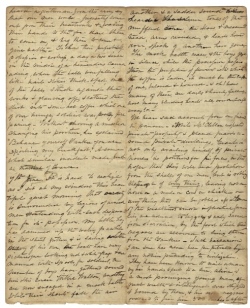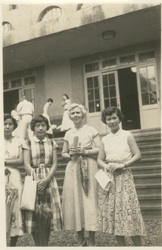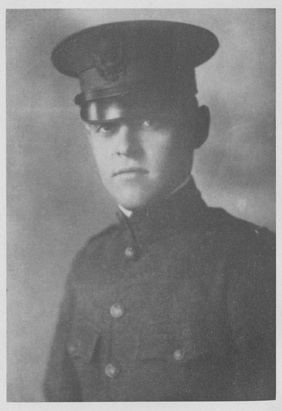Student writers find inspiration in old diaries and letters
by Elizabeth Bramm Dunn
 “Write what you know” is the standard advice to aspiring writers. But Professor Deborah Pope, who has guided the literary efforts of many Duke students, longed to find a way to push those enrolled in her “Writing and Memory” course to move beyond what they know and away from their usual creative voices. Muriel Rukeyser’s series of poems, “The Book of the Dead,” gave Professor Pope an idea. Horrified by the 1936 Union Carbide mining disaster in which many black workers contracted silicosis, the activist poet traveled to Gauley Bridge, West Virginia, to interview victims and their widows, listen to courtroom testimony, and examine documents related to the incident. The poems based on this material were published in U.S. 1 (1938). Pope decided to set her students a similar task: select a group of letters or a diary to serve as a springboard for a linked series of poems.
“Write what you know” is the standard advice to aspiring writers. But Professor Deborah Pope, who has guided the literary efforts of many Duke students, longed to find a way to push those enrolled in her “Writing and Memory” course to move beyond what they know and away from their usual creative voices. Muriel Rukeyser’s series of poems, “The Book of the Dead,” gave Professor Pope an idea. Horrified by the 1936 Union Carbide mining disaster in which many black workers contracted silicosis, the activist poet traveled to Gauley Bridge, West Virginia, to interview victims and their widows, listen to courtroom testimony, and examine documents related to the incident. The poems based on this material were published in U.S. 1 (1938). Pope decided to set her students a similar task: select a group of letters or a diary to serve as a springboard for a linked series of poems.
She turned to me for assistance in identifying materials that might inspire her students. Over a number of weeks, I assembled an annotated list of dozens of collections, grouped by topics such as “Civil War Hospitals,” “Teaching Freedmen,” “Union Organizing,” “Mental Illness,” “Love Letters,” and “World War I.” The class visited Perkins Library’s Mary Duke Biddle Rare Book Room where I introduced them to the protocols of using special collections and showed them letters, diaries, and photographs. During subsequent visits to the reading room, each student selected a collection and began the work of reading the texts and trying to understand their historical and emotional context.
Although the students were daunted initially by sometimes difficult handwriting, unfamiliar allusions, and fragmentary records, they were soon engaged. Katherine Lee Silk, for example, immersed herself in the Civil War-era papers of Lucy Muse Walton Fletcher, wife of a Presbyterian minister. Silk remarked, “I loved this project but it was definitely harder than I expected. Lucy Fletcher was such a great writer herself that many times I feared that whatever I wrote would not do her justice…What really impressed me about this project was my growing interest in it. I’m far from a history buff and so I thought that reading about the Civil War and such might bore me. It had quite the opposite effect. I felt that through reading Lucy’s papers American history came alive for me in a way that no textbook could give me. I wish that I could meet Lucy now that I seem to know her so well. I just hope that my poetry somehow conveys her feelings.” Silk’s poem, “Canvas Fleet, June 7th, 1865,” shows just how successful she was.
Canvas Fleet
June 7th, 1865We are what we learned as children.
Out of the window I watch my son
Playing with red and white canvas sails.
His very own fleet.A chorus of squeals
Another ship is down.
A stream of gutter waterA current of blood.
I hear the tone of drums
Down the street.
A profusion of flowers
Oh Bleeding hearts!I grasp their gaze,
Only the living gaze,
The strong survive.My husband’s head is bowed down.
His words echo
In my ear, my heart.“The battle rages but the war is won.”
The ripples still
As my son looks up.We are all children.
– Katherine Lee Silk
Adam Eaglin chose the papers of another woman who also reflected on the horrors of war.  Eaglin said, “The inspiration for the poem is from the Mary McMillan files—a collection of letters, published documents, and journals by Ms. McMillan, a Protestant missionary who lived in Hiroshima, Japan before and after the [atomic] bomb was dropped. Ms. McMillan’s collected documents tell the amazing story of her experiences in Japan, notable in her perspective as the first Protestant missionary allowed to return to Hiroshima after the disaster. I wrote a series of 3 poems from the documents; the second poem, ‘He cometh with clouds,’ is an imagined letter between Mary and another missionary during the period that she was forced to return to the U.S. The poem intends to capture the horrors of the Hiroshima disaster, and also to highlight Mary’s own anxiety as the war continued. Many of the details in the poem are real—borrowed from essays I found by the principal of the school at which Mary taught in Hiroshima. The principal was at the Hiroshima school the day the disaster occurred.”
Eaglin said, “The inspiration for the poem is from the Mary McMillan files—a collection of letters, published documents, and journals by Ms. McMillan, a Protestant missionary who lived in Hiroshima, Japan before and after the [atomic] bomb was dropped. Ms. McMillan’s collected documents tell the amazing story of her experiences in Japan, notable in her perspective as the first Protestant missionary allowed to return to Hiroshima after the disaster. I wrote a series of 3 poems from the documents; the second poem, ‘He cometh with clouds,’ is an imagined letter between Mary and another missionary during the period that she was forced to return to the U.S. The poem intends to capture the horrors of the Hiroshima disaster, and also to highlight Mary’s own anxiety as the war continued. Many of the details in the poem are real—borrowed from essays I found by the principal of the school at which Mary taught in Hiroshima. The principal was at the Hiroshima school the day the disaster occurred.”
He cometh with clouds
Today I refolded the sheets on my bed sixteen times.
They’re thin between my fingers, a pale-blue cotton,
when shaken, dust flies off the mahogany chests.
It’s cold for August—the glass on the windows
is kissed by ghosts, the color hanging like loose string.Do utensils still feel cold to the touch? I cannot eat.
I reach for the iron forks, but cannot bother to hold them.
I prefer to fumble with my chopsticks, the pair we bought
from the fisherman’s wife at Nishiki market. My fingers
wrap around them like coral, the way I hold this pen now.I write to stay awake. Even now my eyelids grow heavy.
(Promise not to laugh, Eleanor) but I’ve grown frightened of sleep,
there’s poison in my waking breath.
I will tell you of the dreams.Behold, He cometh with clouds, God said.
First there is brightness.
It swells like a purple tide within a cavern,
the splashing clamor of a thousand oceans,
the color grows so bright it dyes the earth white.
My eyes melt into my palms.Then silence, heavier than a mountain—only the voice of the Lord:
Every eye shall see Him, and they also which pierced Him:
and all kindreds of the earth shall wail because of Him.
Is it purgatory in which I find myself,
limbless, imprisoned
swept beneath a flood of fallen timbers?The vision vanishes. I stand atop the hill—
Miss Gaines’ tomb lying before me, and Hiroshima
in one splendid breath, beams beyond the monument.
Eleanor, you are there, beneath the hot Eastern sun,
picnicking with the young girls,
telling them how Miss Gaines founded their school.And when I saw Him, I fell at His feet as dead.
And He laid His right hand
upon me, saying unto me, Fear not;
I am the first and the last.
I realize some of the girls are crying. The body of a girl,
her uniform gone, lies beneath the shade of a cherry tree,
blossoms all around her.
There is another body by the grave.
With terror, I reach out to touch the girls,
they vanish in a flash of smoke.
I call for them by name, dozens of others,
there is an echo of “Miss Mary!” in the distance,
and then, nothing.They emerge from the black smoke as phantoms—
half the little children with eyes burned right out,
clothes singed against flesh.
I take them into my arms,
we all begin to sing,
“He leadeth me, by His own hand He leadeth me.”
One by one they collapse around me.
Silhouettes move around us like a song,
we huddle among the crowd of figures,
some red, others swollen and bleeding,
some without skin at all—only the stench of black flesh.
They are unrecognizable.
“Hai-i!” one calls in Japanese. It has the voice of child.
“Hai-i!” another, it is the sound
of my students, calling from within
or behind these swollen mounds,
I know not which. This is when I awake.“Hai-i” the sound echoes even now in my head like a curse.
Last night, the dream was different.
Again we sat before Miss Gaines’ tomb,
but the city was gone, blurred paint on a canvas,
the towers of buildings, a million faces—crushed into one.I know not what to make of these. Eleanor, please do not think me mad.
As I write this very letter
thick, black clouds gather in the west, concealed by night.
Late in the afternoon a curtain of shadow fell
across the stiff land beyond my bedroom window.
The image hangs in the corner of my eye, news of death,
yet still I pray they carry unseen hope on their sails.
Soon it will glide in through my window,
a Japanese lantern rocking gently on the ocean waves.Mary
– Adam Eaglin
“He cometh with clouds” earned Adam Eaglin the English Department’s 2007 Terry Welby Tyler, Jr. Award, which honors outstanding undergraduate poetry. Wanting to share the good news about the poem, I got in touch with Norma Taylor Mitchell, a friend of Mary McMillan who was instrumental in Duke’s acquisition of the papers. My news inspired her to telephone Mary’s sister, Jane Greenwood, in Mobile, Alabama. In the course of that conversation, Mitchell learned just how fortunate it was that the papers had been placed in Duke’s care: In 2004 the homes in the McMillan family compound in Milton, Florida, including the one where the papers had been stored, were nearly destroyed by Hurricane Ivan.
Like Adam Eaglin and Katherine Lee Silk, Tracy Gold also wrote about war. She used the letters of Frederick Trevenan Edwards and said of them, “While I found it hard to form poetry about the materials I read that was as inspired as the letters themselves, which were written beautifully, I loved reading the materials and becoming immersed in their world. Having access to the original copies of letters from WWI, an era that I was before connected to only through history class, made the lives of those who fought, and their families, so much more tangible. As I read each yellowing page, I found, in such a distant setting, emotions and thoughts that could have been my own friends’, or my own brother’s, making the story found in these letters even more real to me.” Her poem captures both Edwards’ sensitivity and the gritty horrors of World War I.
Eddie waits for orders by the cathedral
and dreams of the waters of Arcady Island;
these dreams have kept him punching
through French wilderness,
as he throws out each sock, gummy with mud,
as he catches an hour of sleep here or there, nothing more;
as the horses die on the roadside;
as reeking mounds of German corpses haunt the air,
chubby German girls smiling from their pockets;Old age in beautiful Arcady…
the childhood breeze
caressing his wrinkled face
while his grandchildren
play in peace…The dreams keep him wading through the mud
to the cathedral, where a shell exploding nearby,
punctures Eddie
9 times
in the chest.– Tracy Gold
 Domestic tragedy skims the surface of Rayhaneh Sharif-Askay’s poem, which she drew from the papers of Reuben Dean Bowen. Bowen lived and worked in Paris, Texas, but his wife and only child, Adelaide, preferred the vibrant early twentieth-century New Orleans. Adelaide’s diaries are filled with accounts of parties and plays, but also reveal a dark side: marital discord, alcohol and drug abuse, and an early death. Rayhaneh Sharif-Askay’s “The Gulf Front at Galveston 1926” reflects the father’s melancholy thoughts at his beloved daughter’s decline.
Domestic tragedy skims the surface of Rayhaneh Sharif-Askay’s poem, which she drew from the papers of Reuben Dean Bowen. Bowen lived and worked in Paris, Texas, but his wife and only child, Adelaide, preferred the vibrant early twentieth-century New Orleans. Adelaide’s diaries are filled with accounts of parties and plays, but also reveal a dark side: marital discord, alcohol and drug abuse, and an early death. Rayhaneh Sharif-Askay’s “The Gulf Front at Galveston 1926” reflects the father’s melancholy thoughts at his beloved daughter’s decline.
The Gulf Front at Galveston 1926
The first condensed milk ever
was made in Galveston, its manufacture
transferred to New York State—at the time,
the greatest dairy state in the Union.
Like gasoline, they would ship the condensed milk
in bulk, drawing it off like molasses.
When I was a young boy,
my mother would send us
to retrieve the stuff in a tin bucket,
traipsing home we would hide ourselves
in an alley and dip our fingers in the sweet stuff,
eat as much of it as we dared to—without being caught.Now you never see it in bulk.
Neither you nor Mama would recognize
the Gulf front of Galveston now.
I remember the days when I would take you there
and you would play on the wet sand,
your letters traced there—as the tide stretched its formless slide
further each time—a promise
of your ever expanding slate,
A delineation to mark
where you would sink or stand—a flat grey plane.
You signed your name there, yet
after the waters foam and flood
your fluid canvas was clean again
I daresay there’s no question
Of what had kept the doctors away back then.
Perhaps now you’ve made markings you can’t rescind.
Will the shoreline absolve you again?– Rayhaneh Sharif-Askay
After the students had celebrated the end of the semester with a poetry reading and reception and Deborah Pope had graded their portfolios, she reflected on the success of the project. “This class has gone so splendidly and the poems emerging from the Special Collections have been so strong, have really provided a way to move the students out of their own default voices and concerns and into others’ experiences, into both public history and the lives of those who endured history but went unremembered, or just those who lived fascinating lives in their own personal, private way.”
In the end, then, the students did follow the “write what you know” advice. Yet, to do that, they had come to know and give voice to the thoughts and experiences of other writers from much different times and places.
 Elizabeth Bramm Dunn is Research Services Librarian at the Rare Book, Manuscript, and Special Collections Library and University Archives
Elizabeth Bramm Dunn is Research Services Librarian at the Rare Book, Manuscript, and Special Collections Library and University Archives
Get more poetry
In response to a request from Elizabeth Dunn, students in Deborah Pope’s “Writing and Memory” class offer these poetry recommendations to the readers of Duke University Libraries.
Molly Knight recommends “any of the volumes by Ron Rash: Eureka Mill, Among the Believers, or Raising the Dead (I would pick Among the Believers if I had to choose one). He’s a NC-born poet who writes these beautiful, unsentimental little poems about poor, rural people in the Carolinas, past and present. Also a master of really subtle form-poetry.”
Melanie Garcia responds, “I like New and Selected Poems: Volume One by Mary Oliver and Staying Alive, an anthology.”
Adam Eaglin’s response: “One of my favorite volumes of poetry is Collected Poems by Sylvia Plath.”
Tracy Gold replies, “I recommend Alice Walker’s Horses Make a Landscape More Beautiful and anything by Octavio Paz.”
Katherine Lee Silk says, “one of my favorite anthologies is The Making of a Poem: A Norton Anthology of Poetic Forms by Mark Strand and Eavan Boland. I also enjoy reading the works of Elizabeth Bishop and T.S. Eliot.”
More information about the poetry mentioned in this article:
Neil Astley, editor. Staying Alive: Real Poems for Unreal Times. New York: Miramax Books, 2003. An anthology of five hundred contemporary poems explores themes of passion, spirituality, death, and friendship, in a collection that includes contributions by such writers as Mary Oliver, W. H. Auden, and Maya Angelou.
Elizabeth Bishop. The Complete Poems. New York: Farrar, Straus, and Giroux, 1969.
T.S. Eliot. Collected Poems, 1909-1965. New York: Harcourt, Brace & Co., 1991.
Mary Oliver. New and Selected Poems, Volume One. Boston: Beacon Press, 1992, 2005.
Octavio Paz. Eliot Weinberger, editor and translator. The Collected Poems of Octavio Paz, 1957-1987. New York : New Directions, 1987. Many other volumes of the poet’s work are available, in both the original Spanish and in English-language translations.
Sylvia Plath. The Collected Poems. New York: HarperPerennial, 1981, 1992.
Ron Rash. Eureka Mill. Corvallis, OR: Bench Press, 1998; 2001 reprint, Spartanburg, SC: Hub City Writers Project.
__ Among the Believers. Oak Ridge, TN: Iris Press, 2000.
__ Raising the Dead. Oak Ridge, TN: Iris Press, 2002.
Muriel Rukeyser. “Book of the Dead,” first published in U.S. 1. New York: Covici, Friede, 1938. In anthologies, including The Collected Poems of Muriel Rukeyser, edited by Janet E. Kaufman & Anne F. Herzog with Jan Heller Levi. Pittsburgh, PA: The University of Pittsburgh Press, 2005.
Mark Strand and Eavan Boland, editors. The Making of a Poem: A Norton Anthology of Poetic Forms. New York: Norton, 2000.
Alice Walker. Horses Make a Landscape Look More Beautiful: Poems. San Diego: Harcourt Brace Jovanovich, 1984.





This was a wonderful article, and the poems were beautiful. What a fantastic way to have history come alive, and to show its continuing relevance. History is always the stories of human beings, in their attempts to live and to live with one another. Thanks to Prof Pope for her creativity, and for Dr. Dunn for her vision and knowledge of the collection. And thanks to the poets for their courage!
I realize that War and death are very real, but in these days it would be very up lifting to read poems of joy and peace. I love Tracy Golds writing, but mabe her next poem can express Life.
Lovely. If Ms. Dunn is the daughter of Dr. Bramm of Huntsville, AL, please have her contat me at david.meigs@ge.com